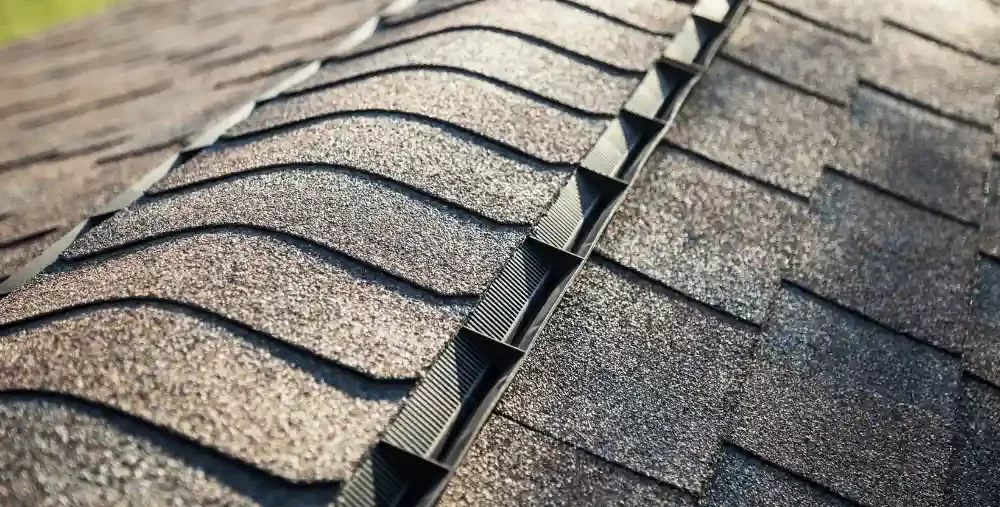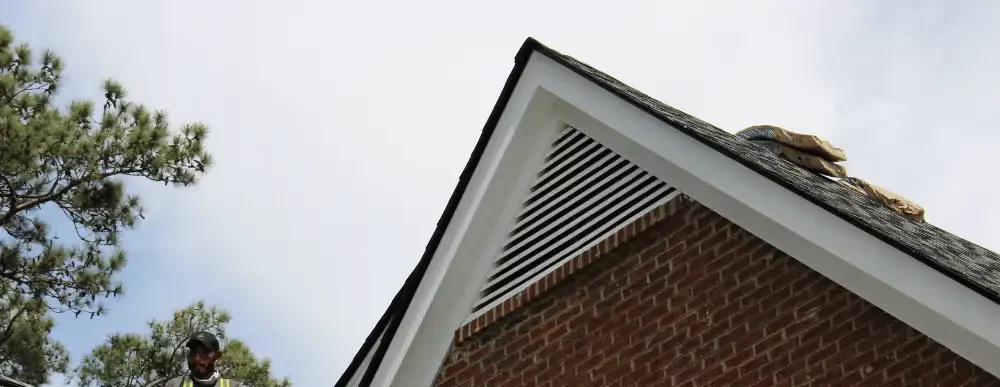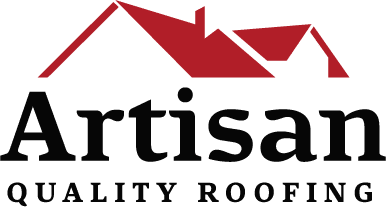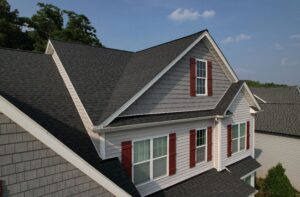
Your attic space serves a purpose that extends beyond that of storage for holiday decorations and boxes of old books. The attic of your home is an important part of your roofing system. For a long-lasting and properly functioning roof system, your attic space needs to have adequate ventilation.
A good vent system for your home means lower energy bills, fewer roof issues, and a safe and healthy home. The roofing repair experts at Artisan Quality Roofing can help you learn everything you need to know about roof vents and which roof ventilation system is best for your home.
What Are Roof Vents?
Your roof is made of an entire roofing system that works together to protect your home. Ventilation is essential to having a healthy roof. Roof vents allow air to circulate through the attic of your home and escape to the outside, avoiding air or moisture to ruminate and become trapped. When air cannot properly circulate and it becomes trapped, this leaves the roof vulnerable to potentially expensive roof repairs and detrimental long-term issues.
Purpose Of Roof Vents
Vent systems in the attic space of your home serve the purpose of keeping your attic cool in the warmer months and dry in the cold, wet months of the year. Having a natural flow of air thanks to the combination of fans and roof vents means that hot, damp, and stale air is able to escape to the outside.
What Happens If My Roof Doesn’t Have Proper Venting?
We know that a good ventilation system for our home is important, but why? Having a continuous flow of air allows for the removal of overheated, stale air and good maintenance of indoor temperatures. However, having a good air ventilation system for your roof comes down to more than just comfort. There are many benefits to proper attic and roof ventilation.
If you are a homeowner and your roof vents are not functioning properly or you think you are in need of a new roof ventilation system, it is important to reach out to professional roofers as soon as possible. If air is not escaping your attic through your roof vents, your home is susceptible to the damaging effects of outdoor elements.
Without proper ventilation for your roof, you risk:
- The growth of harmful mold or mildew
- The creation of ice dams that can create tears in your roof
- Issues with your HVAC system
- Increased energy bill costs
- The need for a new roof replacement sooner than you may have expected
Two Styles of Ventilation for Your Home
Your attic’s ventilation system should be made of a system that keeps air circulating by taking in new air and eliminating old air. It is the balanced attic ventilation system of both intake vents and exhaust vents that keeps attic air moving in and out, allowing for proper roof ventilation.
In order to know the best roof ventilation products for your home, a professional roofing contractor can recommend what will benefit your home most. Their assessment of your roof depends on the square footage of your attic space, the size of your house, and the type and style of your roof.
Intake Vents
Intake vents are responsible for taking new, fresh air in. The air is circulated and eliminated through an exhaust vent, which results in the space becoming cool.
Intake vents are located lower on the roof line than the exhaust vents, usually underneath the eaves of the roof. Since hot air rises, the cool air entering underneath the hot, stale, stagnant air allows that old air to continue to move upward, pushing it out of the attic space.
Some examples of commonly used intake vents are:
- Soffit vents
- Drip-edge vents
- Fascia Vents
Exhaust Vents
If intake vents take new air in, it’s easy to remember that exhaust vents will, in contrast, move stale air out. Exhaust vents are typically located at the top of the roof line, above the lower-lined intake vents.
A properly functioning ventilation system means you have roof ventilation methods that complete the cycle of having that hot, stale, and stagnant air pushed upward and out of the interior spaces of your home through exhaust ventilation.
Having the entire system of intake ventilation and exhaust ventilation working in combination as a team means that moisture is not allowed to sit and accumulate. When moisture enters a space and remains there for a period of time, your home becomes vulnerable to mold and mildew while also compromising the structural integrity of your roof.
Some examples of commonly used exhaust vents are:
- Power vents like hardwired and solar-powered roof vents
- Wind turbines
- Off ridge vents
- Box vents
- Ridge vents
- Cupola vents
- Hip vents

The Most Common Types Of Roof Vents
During your free roof inspection, our contractors can offer insight into the types of roof vents that will benefit your specific home’s ventilation system.
In the meantime, let’s explore the most common types of intake and exhaust vents that help to rid your attic space of hot air while allowing cooler air to enter and continue that necessary cycle of ventilation.
Hardwired Powered Attic Vents
Roof vents that operate on electric power are called hardwired powered vents. These relatively small roof vents are installed on your roof or on its gable. The electric motored fan pushes old, hot air out of the attic space, reducing moisture and humidity in the attic.
Typically, hardwired powered vents are directly wired into your home and controlled by a thermostat or switch for manual operation. Because hardwired-powered vents rely on energy from your home, they are known to often increase energy costs. A lot of modern-day homeowners who want powered vents opt for solar-power-operated systems for energy efficiency and lower costs.
Solar Powered Attic Vents
Solar-powered attic vents are the other type of vents, along with hardwired considered “power vents,” only they are a far more economical choice. These solar-powered attic vents have a solar panel attached to their mount and operate on the energy provided by the sun.
Solar-powered attic vents have alternative operating features and can be controlled by thermostats, humidistats, or manual switches during times when the sun is not offering the heat needed to operate. Not every home will be the ideal type for solar power vents, but if your home gets a lot of natural light during the day and is not shielded by trees or shade, it may be the best roof vent for you.
Box Vents (aka Louver Vents)
Along with ridge vents, box vents are one of the most common exhaust vent types on the market. Made of small, box-shaped holes where it comfortably sits atop the roof, box vents will often be placed in several spots along the top of the roof for ventilation.
Box vents allow wind to flow through and. when used in combination with soffit intake vents, allow hot air to be released through the box vents as moisture is pulled from the attic space.
Ridge Vents
Ridge vents, like box vents, are one of the most popular types of exhaust vents used by homeowners. Ridge vents are modern, reliable choices for expelling and pulling air out of your attic. Rather than pulling hot air from one or two specific spots, the entire ventilation system allows for an even distribution of air.
Ridge vents are installed at the peak of the slope of the roof, making them nearly undetectable to the eye, which is one of the reasons they are so popular among modern-day homeowners.
Cupola Vents
Cupola vents are still used nowadays, but were much more popular ventilation system choices many years ago, particularly popular in rural settings where they are used on sheds and barns or other structures used for livestock.
This does not mean they are useless in regular homes, only they may prove to be overly expensive given the restricted ventilation measures they provide. Most clients who choose cupola vents are interested in the aesthetics of a farmhouses style vent more than its limited performance features. However, when combined with other ventilation efforts to eliminate humid air, they can offer adequate support depending on your home.
Off Ridge Vents
This lesser-known style of roof vents, off-ridge vents require cutouts in the roof for placement and operate similarly to box vents. Mounted within the roof cutout, often at the ridge, these vents are long and thin and operate to remove moisture from your attic space.
Other than being less commonly used than other exhaust vent types, off-ridge vents are sometimes less effective at circulating the air properly because it only covers air circulation in a small, designated space.
Roof Turbines (also known as Whirlybird ventilation)
Powered by the wind, roof turbines work to eliminate the stale air from your attic space to keep it cool and avoid moisture buildup. Despite being traditional and older forms of ventilation, wind turbines are still commonly used to circulate the airflow in your attic space.
Whirlybird vent systems are economical, long-lasting, reliable, and come in a variety of style options that can suit a variety of different style homes, making them a popular choice for homeowners.
Soffit Vents (Most Popular Intake Vent)
Usually installed underneath the eaves of the roof, soffit vents are the most popular type of intake vent on the market. Soffit vents are ideal choices for energy efficiency and reliability, and despite working well alone, will offer the best benefits to your home when combined with a trusted exhaust ventilation system like a ridge vent.
The soft and flexible material of the soffit is great for optimal movement of air, eliminating excessive amounts of air or moisture to be trapped since the soffit keeps it constantly moving.
Over Fascia Vents
Gently sloped roofs, called hip roofs, are the ideal structures for the use of fascia vents. Hip roofs mirror the shape of a pyramid and do not have much in the way of an eave space, therefore, a soffit vent would not be an adequate choice for ventilation on this roof type.
Most homes with this roof shape have open, larger attic spaces that need good circulation for airflow. With fascia vents, the air is pulled into the attic space through the fascia vents of the roof deck.
Contact Artisan Quality Roofing For A Roofing Estimate
Have you noticed poor air quality in your attic space or that your roof ventilation system needs to be repaired or replaced?
At Artisan Quality Roofing, our experts in roof ventilation systems will inspect your roof and determine the best course of action to get old, hot air out of your attic space and properly intake cool air.
Do not allow your home to become victim to mold creating moisture that can affect the health and well-being of your family and your home! Call us today at 919-906-3791 to request a free estimate on roof ventilation services.



